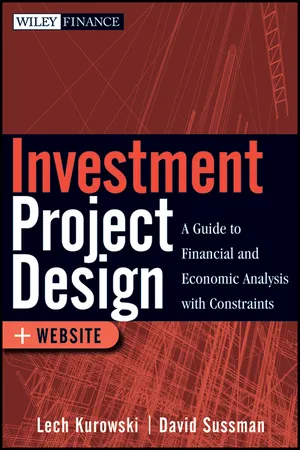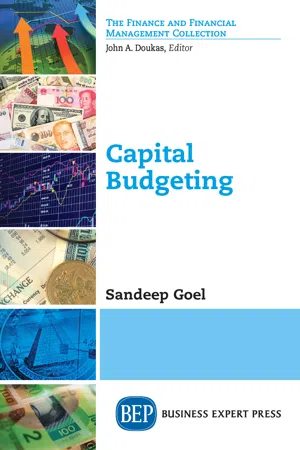Business
Investment Appraisal
Investment appraisal involves evaluating the potential returns and risks of a capital investment to determine its viability. This process typically includes techniques such as net present value (NPV), internal rate of return (IRR), and payback period analysis. By conducting investment appraisals, businesses can make informed decisions about allocating resources to projects or assets, ultimately aiming to maximize profitability and achieve strategic objectives.
Written by Perlego with AI-assistance
Related key terms
8 Key excerpts on "Investment Appraisal"
- eBook - ePub
Accounting and Finance for Managers
A Business Decision Making Approach
- Matt Bamber, Simon Parry(Authors)
- 2020(Publication Date)
- Kogan Page(Publisher)
The apparent sophistication and precision of financial Investment Appraisal techniques can mask shortcomings and behavioural aspects of their application. This chapter therefore includes evaluation of frequently used techniques within a wider behavioural context.Introduction
Investment Appraisal is the process of deciding which projects or assets to invest in. In this chapter we will look at how to evaluate investments from a financial point of view and how such financial analysis fits into the overall investment decision process. Investment Appraisal should always be understood within the wider context of strategic formulation and implementation. Although such matters are beyond the scope of this textbook, this chapter will look at how non-financial factors, risk levels and wider strategic concerns can impinge upon the more traditional concerns of the immediate economic return from an investment.Investment Appraisal, sometimes referred to as capital Investment Appraisal, is concerned with organizational decisions about investment in equipment, machinery, buildings or other long-term assets. This can include a range of types of decision such as replacement of existing assets, investing in new IT or equipment to reduce operating costs, expansion through purchasing new buildings or equipment, improving delivery service or staff training. However, the principles apply equally to investments in shares in companies, whether made by businesses or individuals. Therefore the techniques looked at in this chapter are equally relevant to both businesses and individuals who are involved in making investments.The importance of good Investment Appraisal lies with the strategic and financial importance of the investments made. Investments will shape the future of the organization. Such investments often involve large resources. Wrong decisions can be costly and difficult to reverse and will have a direct impact on the organization’s ability to meet its strategic objectives.From a financial point of view, an investment involves making a cash outlay with the aim of receiving future cash flows in return. At a basic level, assessing the financial viability of an investment involves simply comparing costs with benefits, and ensuring that the benefits outweigh the costs. However, in practice this can prove difficult, as identifying and measuring the costs and benefits from an investment can be a complex task. This chapter will address some of the problems of investment cost–benefit analysis and look at how techniques have developed in order to meet these problems. - eBook - ePub
- Rob Dransfield(Author)
- 2013(Publication Date)
- Routledge(Publisher)
The first part of the chapter looks at a key financial planning decision: whether or not to invest and how to appraise an investment opportunity. Investment involves using scarce resources to create capital to enable future growth. An investment decision is thus important both from the perspective of the economy and for the business carrying out the investment. In evaluating investment opportunities it is important to use Investment Appraisal methods. The chapter therefore explores different ways of appraising investment: the payback method, discounted cash flows and accounting rate of return.Finally, the chapter outlines financial planning within the context of the various sources of finance that are available to a business. Some sources of finance expose a business to greater risks than others, and this can be particularly dangerous when an economy is in recession and funds flowing into a business may be reduced.17.2 What is investment?Investment is a particularly important aspect of economic growth. Economists identify investment as an expenditure on (or purchase of) items that increase productive capacity (e.g. the purchase of a machine or machine tool). In addition, social investment involves investment in the capacity to increase social welfare (e.g. by building a new school or hospital). Investment is particularly important as it typically creates jobs and new expenditure in an economy which acts to boost growth. Investment is carried out by both the public sector and the private sector of the economy. This chapter focuses on various economic techniques that can be used to appraise the effectiveness of investment projects.The development and growth of a business usually takes place in a series of separate steps or projects. These can range from the purchase of an additional delivery van to the complete takeover of another business. These projects are investments because they involve adding to or replacing some of the operating assets of the business. - eBook - ePub
- Paul Emery(Author)
- 2011(Publication Date)
- Routledge(Publisher)
CHAPTER 9
APPRAISING INVESTMENT OPPORTUNITIES
TECHNIQUE DESCRIPTION
For the longevity of any business, managers need to continually replace and augment fixed assets to maintain the business's competitive position and ultimately help it to grow. Put simply, it takes money to make even more money. This requires prudent decisions to choose exactly where, when and how to invest limited sources of money on competing capital projects, and is known as capital budgeting (the planning process used to determine sizeable investments in the long-term assets of an organization – Dayananda, Irons, Harrison, Herbohn and Rowland, 2002). Robust financial techniques are required to carefully evaluate, compare and select between investments that optimize an organization's cash flow and rate of return.To this end this chapter will introduce you to the most frequently used capital budgeting appraisal techniques:payback (PB) – ranks investments according to the period of time after which the investment is expected to break even;accounting or average rate of return (ARR) – uses present monetary values to compare respective returns on investment by dividing total cash flow by the number of years of the investment;net present value (NPV) – considers the whole project to determine its comparable worth to current value through discounting future cash flows and subtracting the initial investment;internal rate of return (IRR) or yield – another discounted cash flow (DCF) method, which considers the point at which the total present value of future cash flows equals the cost of the investment (Solution Matrix, 2010).To appraise whether the investment's financial benefits outweigh the significant costs of a capital project (a business investment opportunity usually involving long-term tangible assets that possess a shelf life of at least three years and a cost of £1,000), these techniques assess likely project returns. The projects that are calculated to ideally provide positive financial net gains can then be compared with the organization's hurdle or baseline standard as well as with one another. - eBook - ePub
Executive Finance and Strategy
How to Understand and Use Financial Information to Set Strategic Goals
- Ralph Tiffin(Author)
- 2014(Publication Date)
- Kogan Page(Publisher)
11 Investment Appraisal Investment strategyA ppraisal is a word much used by finance people, especially when it comes to strategic decisions. We have strategic investment, which can mean investment in non-current assets, tangible and intangible, that add to the infrastructure of the business and enhance earning capacity by means of higher revenues or lower operating costs and more efficient operation. To City folk, investment and strategic investment are more likely to be thought of as investment in companies supporting growth through acquisition strategy. Investment can also mean investment in people.This chapter outlines the models and measures that can be used to assess or appraise whether investment should be made, the essential tools for project appraisal, company valuation etc: this is maybe the most important part of financial strategy, investing for the future. If you want a value- destroying strategy, avoid rigorous Investment Appraisal!There are two paths or strategies to follow when investing: internal investment (growing the business as it exists now) and organic growth. Successful companies are very rigorous with their Investment Appraisal processes, especially where the overall strategy is of continuity and sustainability – that is, one of level or managed growth rather than rampant growth through diversification or more likely acquisition.In some sectors and in the minds of most CEOs whose ‘vision’ is only as far as their exit, organic growth is too slow. Growth must come from acquisition – an acquisition strategy.Whether ‘visions’ are achievable or not is fundamental, but once an acquisition has been identified, proper due diligence should be focused on modelling whether the growth in positive net cash flows is really attainable.Links between investment and financial strategyInvestment in assets, plant and equipment or entire companies can be considered as a strategy and, for some, also the sole objective, that is, to grow by acquisition. Presumably there is a clear objective, that being to make an adequate return on the investment – maybe not in the short term but hopefully the long-term objective is return and not simply growth for growth’s sake. - eBook - ePub
- Aneirin Owen(Author)
- 2007(Publication Date)
- Routledge(Publisher)
Chapter 18 Investment AppraisalThis chapter explores a variety of decision-making techniques.Objectives- Time value of money;
- Net present value (NPV);
- Internal rate of return (IRR);
- Payback period (PBP);
- Accounting rate of return (ARR).
Importance of the SubjectIntroducing business Decisions M anagers take many types of decisions, some concerning the day-to-day running of a department or business and others of strategic importance. Strategic decisions often involve large sums of capital invested in long-term projects. Examples include buying a competitor company, launching a new product, modernising production methods and manufacturing in a foreign location. Once capital is committed to these projects it is difficult to withdraw. For instance, if a manufacturing facility has been planned, built and equipped, the only way to release the funds is to find a buyer for the new facility. This can be difficult, particularly as the most interested parties are likely to be competitors. Good strategic decision making and the careful appraisal of long-term investments is key to business success.Time HorizonsMost managerial tasks operate within a 12-month time horizon. Strategic decisions usually operate within a five to ten-year horizon, which reduces the importance of the distinction between cash and profit. Within one year there can be marked differences between cash flow and profit, because of depreciation, stock, debtors and creditors, etc. Over ten years these differences are insignificant. Consider a business start up situation in which all the equipment and materials are paid for in the first month. The net cash flow profile compared to profits might be as follows:StructureIn every year, especially the first year, there is a marked difference between cash and profit; however, taking the three years in total there is no difference. Because investment opportunities have implications stretching over a number of years, cash provides the more convenient basis for Investment Appraisal decisions, rather than profit. This also helpfully avoids judgmental issues such as depreciation, stock valuation, etc. - eBook - ePub
Investment Project Design
A Guide to Financial and Economic Analysis with Constraints
- Lech Kurowski, David Sussman(Authors)
- 2011(Publication Date)
- Wiley(Publisher)
CHAPTER 8 Project AppraisalAt all stages of development, appraisal is a process of comparing expected performance and other characteristics with stakeholders’ criteria. study and design provide a conceptual project model describing interactions with the environment, performance indicators, and associated risks. at any stage of the process, stakeholders need to assess whether to continue to the next stage—either with analysis of greater depth or, at the final stage, the decision on whether to go ahead with the investment. successful investment of capital resources is almost always supported by reasoned justification, whether or not apparent. however, compact reasoning by a seasoned and successful investor or other stakeholder, underpinned by accumulated experience (that often looks like intuition), can be a useful adjunct to more formal appraisal.Appraisal is essentially a continuous process starting from project conception, with increasing depth and formality as the project approaches the decision point. As design adjustments suggested by feedback from stakeholders, suppliers, and clients are incorporated into the plan, interim reports can be issued noting changes from previous versions. As a practical matter, changes can be compiled over a period of time (e.g., monthly, quarterly) before issuing interim reports, except when a particular change vastly alters the configuration or prospects. Documenting changes can be a daunting task if they take place too frequently.The outlook of prospective stakeholders is determined by their assessment of how effectively their scarce resources are to be employed: for investors, their capital; for lenders, their pool of funds; for guarantors, institutional integrity; for licensors and regulators, social capital. Reward versus risk is a salient concern of all, but it is a subjective matter.1 - eBook - ePub
- David Horner(Author)
- 2020(Publication Date)
- Kogan Page(Publisher)
capital Investment Appraisal (or just Investment Appraisal). This chapter will cover this process.Capital investment
It is worth taking time at this stage to elaborate exactly what we mean by the term capital investment. As mentioned in the opening section, it will normally involve the acquisition of a non-current asset. However, the scale of the investment will depend on the type of firm. For a large company on a multinational level, the investment may be the siting of a new base of operations in a new country. In this case the potential amount of expenditure could run into many millions of pounds. Moving to a new premises or setting up another branch of an existing business would also represent potential capital investment by a firm. For a smaller firm, typical investment decisions will involve the acquisition of machinery, plant or vehicles.Capital Investment Appraisal scenarios are likely to include one or more of the following:- replacement of existing non-current assets, such as machinery and equipment;
- upgrading of existing non-current assets, where the replacement will lead to cost savings for the business;
- deciding between alternative investments – where several options exist, of which only one can be selected;
- moving premises – usually either to boost revenues or to reduce costs;
- expansion of the business, through the acquisition of expanded production facilities;
- launching a new product – the costs and benefits associated with the launch of a new product.
In each case of Investment Appraisal we are comparing the certainty of the cost of an investment which will be paid for in the present time with the future expected benefits of the investment (in terms of extra revenue generated or savings in terms of cost reductions). Although it is not necessary for the business to pay for the investment out of its own resources – it could borrow the money to finance the investment – the business will normally be looking for projects which generate more money (or save more in terms of cost reductions) than the cost of the investment. - eBook - ePub
- Sandeep Goel(Author)
- 2015(Publication Date)
- Business Expert Press(Publisher)
SECTION 2 Capital Budgeting Decision & AppraisalPassage contains an image CHAPTER 2 Capital Budgeting: Nature & Scope
IntroductionThe Present ChapterIt discusses the concept of capital budgeting, its process, techniques, and risk analysis of capital investment decisions by the business units.Capital budgeting decision relates to decision of investment in long-term projects. Capital budgeting is often used interchangeably with capital expenditure or capital investment. Any expenditure that generates a cash flow benefit for more than one year, it is a capital expenditure. For example, the purchase of new equipment, expansion of production capacity, buying another company, research & development, and so on. Capital budgeting involves large cash outlays for generating future return of the company. Once, a capital budgeting decision is committed, it is often difficult to reverse. Therefore, we need to carefully analyze and evaluate proposed capital budgeting decisions.“Capital Budgeting is long-term planning for making and financing proposed capital outlays.” —Charles T. Horngnen “Capital budgeting is concerned with the firm’s formal process for the acquisition and investment of capital.” —Hamption, John. J.In a capital investment decision, the major criterion for selection of a project is its viability and impact on shareholder value. The two most important parameters for arriving at a project decision are the project’s expected cash inflows and outflows. They determine whether the returns meet a sufficient target benchmark or not.Capital Budgeting Decision: An OverviewThe capital budgeting decision, as already pointed out, pertains to investment in fixed assets/long-term assets and the returns are expected over a long period of time. It is the process of identifying, analyzing, and selecting investment projects whose returns (cash flows) are expected to extend beyond one year.1
Learn about this page
Index pages curate the most relevant extracts from our library of academic textbooks. They’ve been created using an in-house natural language model (NLM), each adding context and meaning to key research topics.







